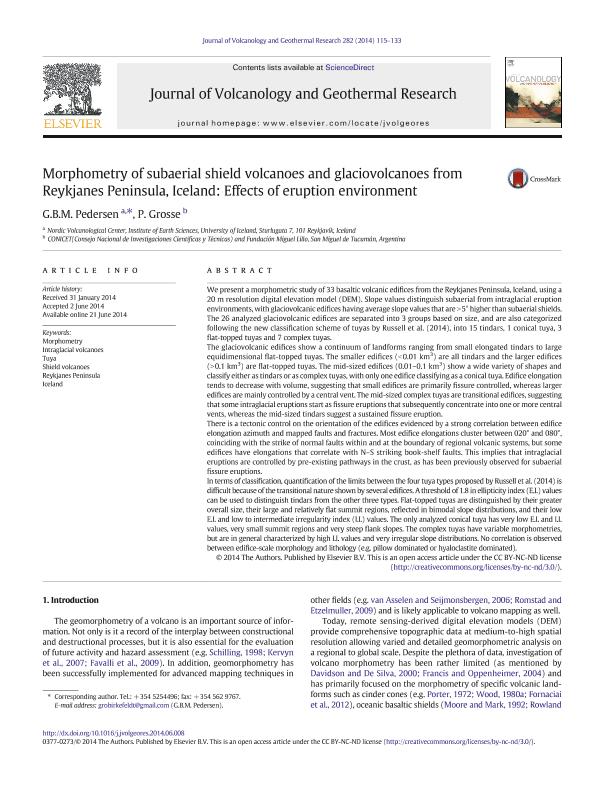Mostrar el registro sencillo del ítem
dc.contributor.author
Pedersen, G. B. M.
dc.contributor.author
Grosse, Pablo

dc.date.available
2016-08-22T15:19:35Z
dc.date.issued
2014-08
dc.identifier.citation
Pedersen, G. B. M.; Grosse, Pablo; Morphometry of subaerial shield volcanoes and glaciovolcanoes from Reykjanes Peninsula, Iceland: Effects of eruption environment; Elsevier Science; Journal Of Volcanology And Geothermal Research; 282; 8-2014; 115-133
dc.identifier.issn
0377-0273
dc.identifier.uri
http://hdl.handle.net/11336/7273
dc.description.abstract
We present a morphometric study of 33 basaltic volcanic edifices from the Reykjanes Peninsula, Iceland, using a 20 m resolution digital elevation model (DEM). Slope values distinguish subaerial from intraglacial eruption environments, with glaciovolcanic edifices having average slope values that are > 5° higher than subaerial shields. The 26 analyzed glaciovolcanic edifices are separated into 3 groups based on size, and are also categorized following the new classification scheme of tuyas by Russell et al. (2014), into 15 tindars, 1 conical tuya, 3 flat-topped tuyas and 7 complex tuyas.
The glaciovolcanic edifices show a continuum of landforms ranging from small elongated tindars to large equidimensional flat-topped tuyas. The smaller edifices (< 0.01 km3) are all tindars and the larger edifices (> 0.1 km3) are flat-topped tuyas. The mid-sized edifices (0.01–0.1 km3) show a wide variety of shapes and classify either as tindars or as complex tuyas, with only one edifice classifying as a conical tuya. Edifice elongation tends to decrease with volume, suggesting that small edifices are primarily fissure controlled, whereas larger edifices are mainly controlled by a central vent. The mid-sized complex tuyas are transitional edifices, suggesting that some intraglacial eruptions start as fissure eruptions that subsequently concentrate into one or more central vents, whereas the mid-sized tindars suggest a sustained fissure eruption.
There is a tectonic control on the orientation of the edifices evidenced by a strong correlation between edifice elongation azimuth and mapped faults and fractures. Most edifice elongations cluster between 020° and 080°, coinciding with the strike of normal faults within and at the boundary of regional volcanic systems, but some edifices have elongations that correlate with N–S striking book-shelf faults. This implies that intraglacial eruptions are controlled by pre-existing pathways in the crust, as has been previously observed for subaerial fissure eruptions.
In terms of classification, quantification of the limits between the four tuya types proposed by Russell et al. (2014) is difficult because of the transitional nature shown by several edifices. A threshold of 1.8 in ellipticity index (E.I.) values can be used to distinguish tindars from the other three types. Flat-topped tuyas are distinguished by their greater overall size, their large and relatively flat summit regions, reflected in bimodal slope distributions, and their low E.I. and low to intermediate irregularity index (I.I.) values. The only analyzed conical tuya has very low E.I. and I.I. values, very small summit regions and very steep flank slopes. The complex tuyas have variable morphometries, but are in general characterized by high I.I. values and very irregular slope distributions. No correlation is observed between edifice-scale morphology and lithology (e.g. pillow dominated or hyaloclastite dominated).
dc.format
application/pdf
dc.language.iso
eng
dc.publisher
Elsevier Science

dc.rights
info:eu-repo/semantics/openAccess
dc.rights.uri
https://creativecommons.org/licenses/by-nc-nd/2.5/ar/
dc.subject
Morphometry
dc.subject
Intraglacial Volcanoes
dc.subject
Tuya
dc.subject
Shield Volcanoes
dc.subject
Reykjanes Peninsula
dc.subject
Iceland
dc.subject.classification
Vulcanología

dc.subject.classification
Ciencias de la Tierra y relacionadas con el Medio Ambiente

dc.subject.classification
CIENCIAS NATURALES Y EXACTAS

dc.title
Morphometry of subaerial shield volcanoes and glaciovolcanoes from Reykjanes Peninsula, Iceland: Effects of eruption environment
dc.type
info:eu-repo/semantics/article
dc.type
info:ar-repo/semantics/artículo
dc.type
info:eu-repo/semantics/publishedVersion
dc.date.updated
2016-08-17T15:40:29Z
dc.journal.volume
282
dc.journal.pagination
115-133
dc.journal.pais
Países Bajos

dc.journal.ciudad
Amsterdam
dc.description.fil
Fil: Pedersen, G. B. M.. University of Iceland. Institute of Earth Sciences. Nordic Volcanological Center; Islandia
dc.description.fil
Fil: Grosse, Pablo. Fundación Miguel Lillo; Argentina. Consejo Nacional de Investigaciones Científicas y Técnicas. Centro Científico Tecnológico Tucumán; Argentina
dc.journal.title
Journal Of Volcanology And Geothermal Research

dc.relation.alternativeid
info:eu-repo/semantics/altIdentifier/url/http://www.sciencedirect.com/science/article/pii/S0377027314001838
dc.relation.alternativeid
info:eu-repo/semantics/altIdentifier/doi/http://dx.doi.org/10.1016/j.jvolgeores.2014.06.008
dc.relation.alternativeid
info:eu-repo/semantics/altIdentifier/doi/10.1016/j.jvolgeores.2014.06.008
Archivos asociados
